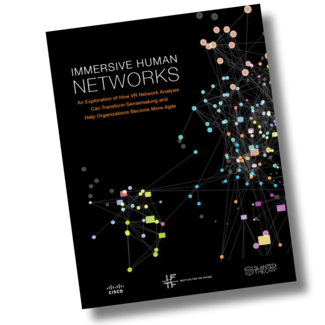Collaborative VR Data Visualization Prototype
Immersive Human Networks
An Exploration of How VR Network Analysis Can Transform Sensemaking and Help Organizations Become More Agile
Organizational network analysis approaches have been used for more than two decades to help make visible the informal patterns, information flows, and collaboration pathways that characterize complex systems. They can, for example, help us identify the important role brokers play in bridging the gaps that separate different clusters within a network. But while traditional network analysis tools have yielded useful insights, the nature of work has continued to change, and organizations need innovative perspectives and tools to address these new challenges.
This research report contextualizes and documents a new network analysis approach that has the potential to transform how people in organizations make
sense of, enact, and respond creatively to change. The Organizational Network in Virtual Reality (ONVR) application is a proof-of-concept prototype that enables multiple users to collaboratively interact with network graphs in the volumetric space of virtual reality. The prototype was initiated by Cisco HR, with the objective of augmenting and scaling their existing 2D human network platform through the innovative lens of immersive experience design.
Cisco HR has been blazing new trails in organizational network analysis by placing the network map at the center of interaction and empowering the entire organization to leverage network intelligence. With ONVR, the LTI Digitalization Office wanted to explore new ways of working with large-scale network data, to evaluate innovative approaches to extracting intelligence in a 3D environment, and to demonstrate to Cisco leadership the transformative potential of collaborative VR environments to support new kinds of network insights. Slanted Theory built ONVR on top of its VR data-visualization platform as a custom exploration of multiuser collaborative network analysis utilizing Cisco datasets and use cases.
We aim in this report to share insights surfaced by the prototype development, expert interviews, and a literature and landscape review. We first situate VR network analysis within the broader context of changing organizational demands and workplace challenges. We identify the transformative potential of VR network analytics and call attention to the concept of embodied cognition. We then describe and analyze the features of ONVR. Finally, we identify possibilities for the future opened up by immersive sensemaking tools like ONVR, focusing on new approaches to 3D data visualization and analytics, organizational ritual design, and organizational structures inspired by biology. These emerging opportunities will transform work and workplace relations by reshaping the ways we engage with and think about our human networks.




